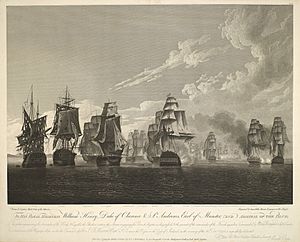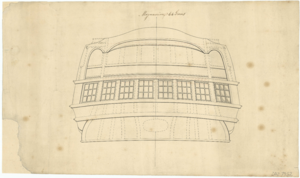HMS Magnanime (1780) facts for kids

Magnanime
|
|
Quick facts for kids History |
|
|---|---|
| Name | HMS Magnanime |
| Ordered | 16 October 1775 |
| Builder | Deptford Dockyard |
| Laid down | 23 August 1777 |
| Launched | 14 October 1780 |
| Commissioned | October 1780 |
| Fate | Broken up at Sheerness Dockyard, July 1813 |
| Notes | Razeed to a 44-gun fifth rate, 1795 |
| General characteristics | |
| Class and type | Intrepid-class ship of the line |
| Tons burthen | 1369+51⁄94 bm |
| Length |
|
| Beam | 44 ft 4 in (13.51 m) |
| Depth of hold | 19 ft (5.8 m) |
| Propulsion | Sails |
| Sail plan | Full-rigged ship |
| Complement | 500 (as 64-gun ship); 310 officers and men (as frigate) |
| Armament |
|
HMS Magnanime was a powerful warship of the Royal Navy, the navy of Great Britain. It was a 64-gun ship of the line, meaning it carried 64 cannons! Launched on October 14, 1780, it was built at Deptford Dockyard.
This ship was part of the Intrepid class, designed by Sir John Williams. Later, Magnanime was changed into a smaller, faster 44-gun frigate. This process was called "razeeing."
Contents
Life of a Warship: HMS Magnanime's Journey
Magnanime began its service in October 1780 under Captain Charles Wolseley. Its first big mission was in 1781, when it sailed with a group of ships to help Gibraltar.
Battles in the Indian Ocean
After Gibraltar, Magnanime traveled all the way to the Indian Ocean. There, it took part in several important battles against French forces. These included the Battle of Providien, Negapatam, and Battle of Trincomalee in 1782. It also fought in the Battle of Cuddalore in 1783.
After these battles, Magnanime returned to the United Kingdom. In June 1784, it was placed "into ordinary," which meant it was put into storage or reserve.
Becoming a Frigate
From 1794 to 1795, Magnanime underwent a major change. It was "razeed," meaning its upper deck was removed. This transformed it from a large 64-gun ship of the line into a smaller, faster 44-gun frigate.
In November 1794, the ship was ready for action again. It was recommissioned under Captain Isaac Schomberg.
Chasing Privateers
On March 16, 1798, Magnanime was protecting a group of merchant ships. Suddenly, they spotted a privateer nearby. Privateers were privately owned ships that were allowed by their government to attack enemy ships.
Captain Michael de Courcy, who was now in command, ordered Magnanime to chase the privateer. After a long chase of 23 hours and 256 miles, they caught it! The privateer was named Eugénie. It had 18 guns, but it had thrown eight of them overboard during the chase to try and escape. Eugénie was a new ship with a crew of 107. The Royal Navy took it and renamed it HMS Pandour, but it was never used in service.
Just a few weeks later, on April 1, Magnanime had another successful chase. This time, it was 180 miles in 18 hours! The captured privateer was called Audacieux. It had 20 guns and a crew of 137. Captain de Courcy noted that Audacieux was very fast. He believed it would have escaped if its captain had steered better. This ship was also taken into the Royal Navy as HMS Audacieux, but it was never officially used.

Capturing Gorée
In spring 1799, Captain William Taylor took command of Magnanime. He sailed it along the African coast. In April 1801, he helped capture Gorée from the French.
Magnanime was part of a group of ships led by Captain Sir Charles Hamilton. Hamilton had heard that three French frigates were at Gorée. He sailed there with Magnanime and another ship, HMS Ruby. The French frigates were not there, so Hamilton demanded that the governor of Gorée surrender. The governor agreed, and the British took control on April 5.
Later, Magnanime served in the Leeward Islands until the end of the French Revolutionary Wars. In 1802, it was again put into reserve.
Later Years and Final Fate
During the Napoleonic Wars, Magnanime served in different ways. It was used as a floating battery, which is like a floating fort. Later, it became a hospital ship, helping sick and injured sailors.
Magnanime was eventually taken apart, or "broken up," in July 1813.
|


